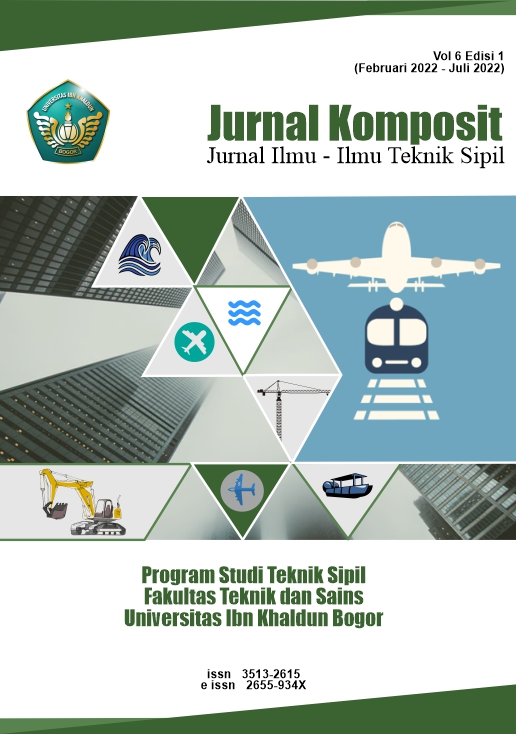Perhitungan Kapasitas Pengaliran Kali Cipinang dari Kelurahan Kebon Pala sampai dengan Banjir Kanal Timur dalam Pengendalian Banjir
DOI:
https://doi.org/10.32832/komposit.v6i1.6696Abstract
ABSTRAK
Masalah banjir yang terjadi didaerah perkotaan khususnya Jakarta sudah menjadi suatu hal yang biasa dan sudah menjadi agenda setiap musim penghujan tiba. Penelitian dilakukan dari daerah Kebon Pala sampai dengan Banjir Kanal Timur, yaitu daerah yang dilalui kali Cipinang. Penelitian ini menggunakan metode kuantitatif. Penelitian ini bertujuan untuk mengidentifikasi perhitungan curah hujan pada periode ulang, perhitungan kapasitas pengaliran alur sungai, dan perencanaan ulang dimensi alur sungai yang menjadi salah satu upanya untuk pengendalian banjir. Metode rata-rata aljabar menjadi alternatif perhitungan data curah hujan yang kemudian dilakukan perhitungan distribusi dengan pengujian kesesuaian distribusi yaitu Chi-Kuadrat. Perhitungan debit banjir dengan menggunakan Metode HSS Nakayasu dan perhitungan kapasitas pengaliran menggunakan perhitungan manual dengan rumus Manning. Penelitian ini difokuskan pada kemampuan atau kapasitas pengaliran alur sungai untuk mngalirkan debit banjir pada periode ulang.
Kata kunci: Pengendalian Banjir, Sungai Cipinang, Kapasitas Pengaliran Sungai, Distibusi Frekuensi.
ABSTRACT
The problem of flooding in urban areas, especially Jakarta, has become a common thing and has become an agenda every rainy season arrives. The research was conducted from the Kebon Pala area to the East Flood Canal, which is the area that the Cipinang river passes through. This study uses quantitative methods. This study aims to identify the calculation of rainfall in the return period, the calculation of the capacity of the river channel flow, and the redesign of the river channel dimensions which is one of the efforts for flood control. The algebraic average method is used as an alternative to calculating the rainfall data, which is then testing the suitability of the distribution. Calculation of flood discharge using the Nakayasu HSS's method and calculation of drainage capacity using manual calculations with the Manning's formula. This research focuses on the ability or capacity of the river channel to flow flood discharge in the return period. Based on the results of the study, it is known that the existing dimensions of the Kebon Pala river channel with a width of 15 m and a river channel depth of 1.2 m are only able to drain a flood discharge of 76.074 m³/second. With the trial and error method on the dimensions of the planned river, the width is 18 m and the depth is 2.1 m with the flow rate of 192.498 m³/second.
Keywords: Flood management, Cipinang river, river capacity, distribution of frequency.
References
Basuki, B., Winarsih, I., & Adhyani, N. L. (2009). Analisis Periode Ulang Hujan Maksimum dengan Berbagai Metode (Return Periode Analyze maximum Rainfall with Three Method). Agromet, 23(2), 76. https://doi.org/10.29244/j.agromet.23.2.76-92
Hariati, F., Saputra, D., Alimuddin, A., & Yanuarsyah, I. (2020). Dampak Peningkatan Intensitas Hujan dan Tutupan Lahan Terhadap Debit Banjir Puncak Sungai Ciseel. Jurnal Komposit, 4(1), 1–6. https://doi.org/10.32832/komposit.v4i1.3748
Hendrawan, D., Harisuseno, D., & Dermawan, V. (2020). Upaya Normalisasi Sungai Ciliwung dengan Penampang Ganda Jembatan Kalibata - Pintu Air Manggarai Kecamatan Kebayoran baru DKI Jakarta. Jurnal Mahasiswa Jurusan Teknik Pengairan, 3(2). http://pengairan.studentjournal.ub.ac.id/index.php/jmtp/article/view/536/275
Maitsa, T. R., Kuntoro, A. A., & Septiadi, D. (2021). Analisis Tren Perubahan Intensitas Hujan (Studi Kasus: Jakarta dan Bogor). Jurnal Teknik Sipil, 28(2), 163–172. https://doi.org/10.5614/jts.2021.28.2.5
Putuhena, W. M., & Ginting, S. (2013). Pengembangan Model Banjir Jakarta. Jurnal Teknik Hidraulik, 4(1), 63–78. https://www.researchgate.net/publication/328265443_PENGEMBANGAN_MODEL_BANJIR_JAKARTA
Ramadhayanti, Z. (2014). Implementasi Kebijakan Pengendalian Banjir Provinsi DKI Jakarta melalui Proyek Kanal Banjir Timur. Journal of Politic and Government, 1–22. https://ejournal3.undip.ac.id/index.php/jpgs/article/view/8749
Saputra, L., Hariati, F., & Alimuddin, A. (2018). Analisis Kapasitas Sungai Ciparigi Terhadap Debit Banjir Kala Ulang. Jurnal Komposit, 2(2), 100.
Satriadi, I. (2017). Analisis Hidrograf Banjir Saluran Irigasi Cibalok. Astonjadro: CEAESJ, 6(1), 49–59. https://doi.org/10.32832/astonjadro.v6i1.2261
Taqwa, F. M. L. (2017). Perencanaan Normalisasi Arus Sungai Cijere di Desa Pasirmukti Kec. Citeureup Kab. Bogor. Jurnal Komposit, 1(2), 31–43. https://doi.org/10.32832/komposit.v1i2.1544
Wigati, R., Soedarsono, S., & Pribadi, P. (2016). Normalisasi Sungai Ciliwung Menggunakan Program HEC-RAS 4.1 (Studi Kasus Cililitan - Bidara Cina). Jurnal Fondasi, 5(1), 1–12. http://jurnal.untirta.ac.id/index.php/jft/article/view/1242
Downloads
Published
How to Cite
Issue
Section
License
Authors who publish with this journal agree to the following terms (Penulis yang mengajukan publikasi artikel telah menyetujui hal berikut):
- Through this publication, the author agree to submit the copyright of article writing to Jurnal Komposit: Jurnal Ilmu-ilmu Teknik Sipil. This copyright submission takes the form of, but is not limited to: reproduction of the article and parts therein, including photographic reproductions; distribution of articles through printed and electronic documents; and translation of articles(Bahwa melalui publikasi ini, hak cipta penulisan artikel diserahkan kepada Jurnal Komposit: Jurnal Ilmu-ilmu Teknik Sipil. Penyerahan hak cipta ini berupa, namun tidak terbatas pada: perbanyakan artikel dan bagian di dalamnya, termasuk reproduksi fotografi; penyebarluasan artikel melalui dokumen cetak dan elektronik; serta penterjemahan artikel).
- The authors agree to the terms of the Copyright Notice, according to Creative Commons Attribution-NonCommercial-ShareAlike 4.0 International License., which will apply to this article if and when it is published by Jurnal Komposit: Jurnal Ilmu-ilmu Teknik Sipil. (Para penulis setuju dengan ketentuan Pemberitahuan Hak Cipta, sesuai dengan Lisensi Internasional Creative Commons Attribution-NonCommercial-ShareAlike 4.0., yang akan berlaku untuk artikel ini jika dan ketika diterbitkan oleh Jurnal Komposit: Jurnal Ilmu-ilmu Teknik Sipil).

This work is licensed under a Creative Commons Attribution-NonCommercial-ShareAlike 4.0 International License.



.png)










